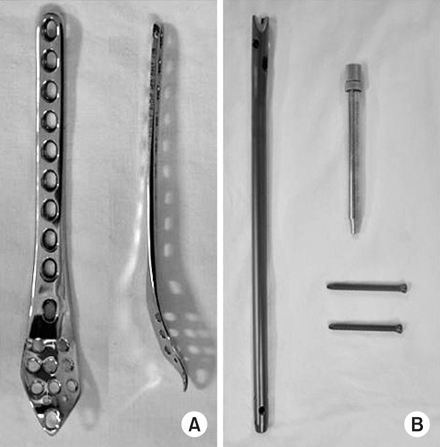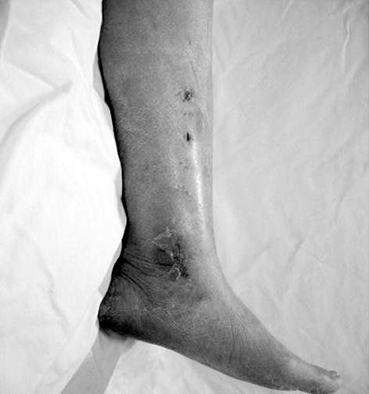J Korean Fract Soc.
2010 Jul;23(3):296-302. 10.12671/jkfs.2010.23.3.296.
Comparative Study Using of Treatment with Minimally Invasive Plate Osteosynthesis Using Periarticular Plate and Interlocking Intramedullary Nailing in Distal Tibia Fractures
- Affiliations
-
- 1Department of Orthopedic Surgery, College of Medicine, Soonchunhyang University, Cheonan, Korea. chhong@sch.ac.kr
- KMID: 1712345
- DOI: http://doi.org/10.12671/jkfs.2010.23.3.296
Abstract
- PURPOSE
To compare the result of treatment between minimally invasive plate osteosynthesis (MIPO) using periarticular plate and intramedullary nailing in treatment of distal tibia fractures.
MATERIALS AND METHODS
28 cases of distal tibia fractures form Jan. 2006 to Mar. 2008 were divided into two group. Minimum follow-up was for 12 month. Group 1 consisted of 14 patients who were treated by MIPO technique and group 2 consisted of 14 patients who were treated by interlocking intramedullary nailing. The results were compared by assessing radiologic and clinical result.
RESULTS
The mean bony union time was 14 weeks (8~17) in group 1 and 15 weeks (11~20) in group 2. Operation time was 58 minutes (55~65) in group 1 and 82.7 minutes (70~100) in group 2. The average angulation in AP view was 1.5 degrees (0~2) in group 1 and 2 degrees (0~5) in group 2, in lateral view was 1.8 degrees (0~4) in group 1 and 2.3 degrees (0~12) in group 2. The average range of motion for dorsi flextion was 17.5 degrees (15~20) in group 1 and 18 degrees (16~20) in group 2, for plantar flextion was 45 degrees (42~50) in group 1 and 44 degrees (42~50) in group 2, which means that there were no severe limitation of motion in all patients, resulting in satisfactory ambulation. There was no post operative complications such as skin irritation problem caused by internal device and no implant failure and superficial wound infection.
CONCLUSION
There were no difference in bony union time, clinical result and anatomical reduction between Group 1 and Group 2 in distal tibia fractures, but operation time was shorter in MIPO than nailing.
Keyword
MeSH Terms
Figure
Reference
-
1. Borg T, Larsson S, Lindsjo U. Percutaneous plating of distal tibial frctures. Preliminary result in 21 patients. Injury. 2004. 35:608–614.2. Böstman O, Hänninen A. The fibular reciprocal fracture in tibial shaft fractures caused by indirect violence. Arch Orthop Trauma Surg. 1982. 100:115–121.
Article3. Brumback RJ, McGarvey WC. Frature of the tibial plafond. Evolving treatment concepts for the pilon fracture. Orthop Clin North Am. 1995. 26:273–285.4. Chang SA, Ahn HS, Byun YS, Kim JH, Bang HH, Kwon DY. Minimally invasive plate osteosynthesis in unstable fractures of the distal tibia. J Korean Fract Soc. 2005. 18:155–159.
Article5. Ghera S, Santori FS, Calderaro M, Giorgini TL. Minimally invasive plate osteosynthesis in distal tibial fractures: pitfalls and surgical guidelines. Orthopedics. 2004. 27:903–905.
Article6. Hahn D, Bradbury N, Hartley R, Radford PJ. Intramedullary nail breakage in distal fractures of the tibia. Injury. 1996. 27:323–327.
Article7. Helfet DL, Koval K, Pappas J, Sanders RW, Dipasquale T. Intraarticular "Pilon" fracture of the tibia. Clin Orthop Relat Res. 1994. (298):221–228.
Article8. Helfet DL, Shonnard PY, Levine D, Borrelli J Jr. Minimally invasive plate osteosynthesis of distal fractures of the tibia. Injury. 1997. 28:Suppl 1. A42–A47.
Article9. Helfet DL, Suk M. Minimally invasive percutaneous plate osteosynthesis of fracture of the distal tibia. Instr Course Lect. 2004. 53:471–475.10. Im GI, Kim DY, Shin JH, Youn KS, Cho WH. Comparative analysis of interlocking nail and anatomical plate in the treatment of distal tibial fracture. J Korean Soc Fract. 1999. 12:632–637.
Article11. Krettek C, Stephan C, Schandelmaier P, Richter M, Pape HC, Miclau T. The use of Poller screws as blocking screws in stabilizing tibial fractures treated with small diameter intramedullary nails. J Bone Joint Surg Br. 1999. 81:963–968.12. Leone VJ, Ruland RT, Meinhard BP. The management of the soft tissues in pilon fractures. Clin Orthop Relat Res. 1993. (292):315–320.
Article13. McKibbin B. The biology of fracture healing in long bones. J Bone Joint Surg Br. 1978. 60-B:150–162.
Article14. McFerran MA, Smith SW, Boulas HJ, Schwartz HS. Complications encountered in the treatment of pilon fractures. J Orthop Trauma. 1992. 6:195–200.
Article15. Melis GC, Sotgiu F, Lepori M, Guido P. Intramedually nailing in segmental tibial fractures. J Bone Joint Surg Am. 1981. 63:1310–1318.16. Merchant TC, Dietz FR. Long-term follow-up after fractures of the tibial and fibular shafts. J Bone Joint Surg Am. 1989. 71:599–606.
Article17. Mosheiff R, Safran O, Segal D, Leibergall M. The undreamed tibial nail in the treatment of distal metaphyseal fractures. Injury. 1999. 30:83–90.
Article18. Na HY, Park YJ, Ko SH, Choe WS, Lee YS, Yoon KD. Comparative analysis of interlocking IM nailing and LC-DCP fixation in the treatment of distal tibial fracture. J Korean Soc Fract. 2002. 15:152–158.
Article19. Oh CW, Kyung HS, Park IH, Kim PT, Ihn JC. Distal tibia metaphyseal fractures treated by percutaneous plate osteosynthesis. Clin Orthop Relat Res. 2003. (408):286–291.
Article20. Oh CW, Park BC, Kyung HS, et al. Percutaneous plating for unstable tibial fractures. J Orthop Sci. 2003. 8:166–169.
Article21. Park KC, Park YS. Minimally invasive plate osteosynthesis for distal tibial metaphyseal fracture. J Korean Fract Soc. 2005. 18:264–268.
Article22. Robinson CM, McLauchlan GJ, McLean IP, Court-Brown CM. Distal metaphyseal fractures of the tibia with minimal involvement of the ankle. Classification and treatment by locked intramedually nailing. J Bone Joint Surg Br. 1995. 77:781–787.23. Wyrsch B, McFerran MA, McAndrew M, et al. Operative treatment of fractures of the tibial plafond. A randomized, prospective study. J Bone Joint Surg Am. 1996. 78:1646–1657.
Article24. Zelle BA, Bhandari M, Espiritu M, Koval KJ, Zlowodzki M. Evidence-Based Orthopaedic Trauma Working Group. Treatment of distal tibia fractures without articular involvement: a systematic review of 1125 fractures. J Orthop Trauma. 2006. 20:76–79.
Article
- Full Text Links
- Actions
-
Cited
- CITED
-
- Close
- Share
- Similar articles
-
- Comparative Analysis of Minimally Invasive Plate Osteosynthesis Using Periarticular Plate and Intramedullary Nailing in Distal Tibial Metaphyseal Fractures
- Minimally Invasive Percutaneous Plate Osteosynthesis Using Periarticular Plate for Distal Tibial Fractures
- Comparative Study of Intramedullary Nailing and Plate for Metaphyseal Fractures of the Distal Tibia
- A Comparison of the Results between Intramedullary Nailing and Minimally Invasive Plate Osteosynthesis in Distal Tibia Fractures
- A Comparison between Minimally Invasive Plate Osteosynthesis & Interlocking Intramedullary Nailing in Distal Tibia Fractures





